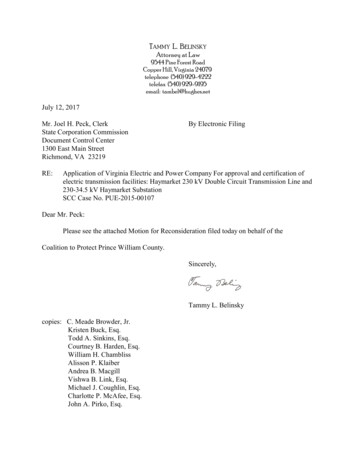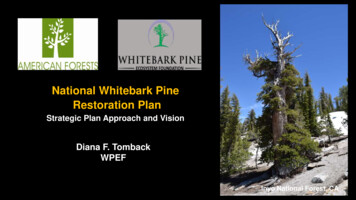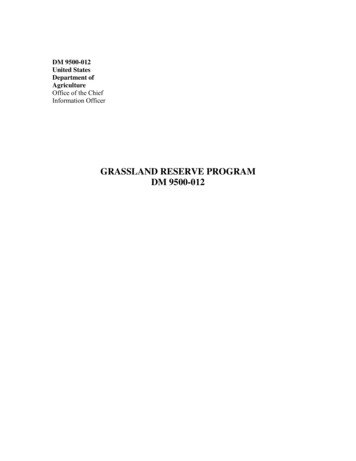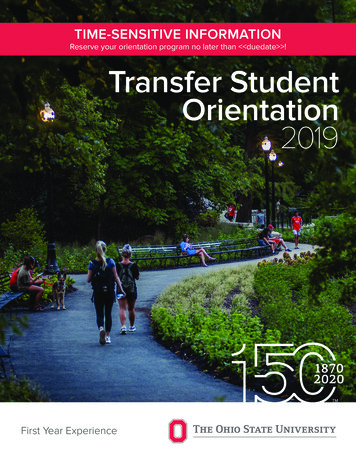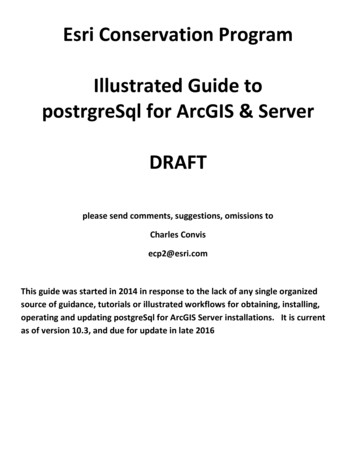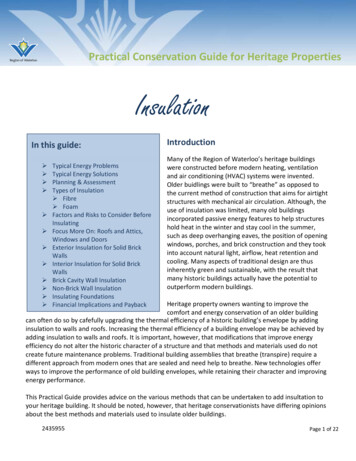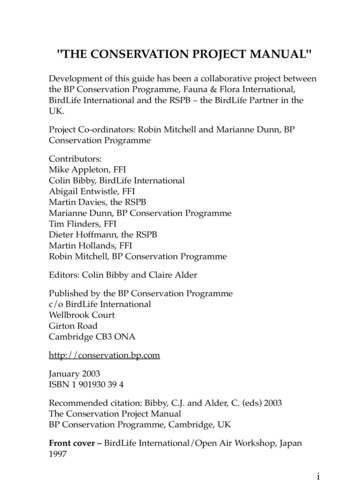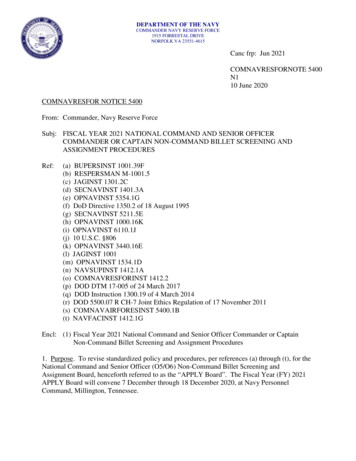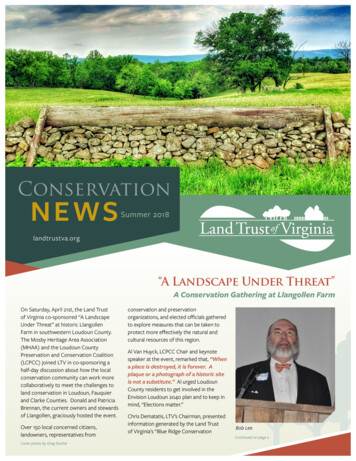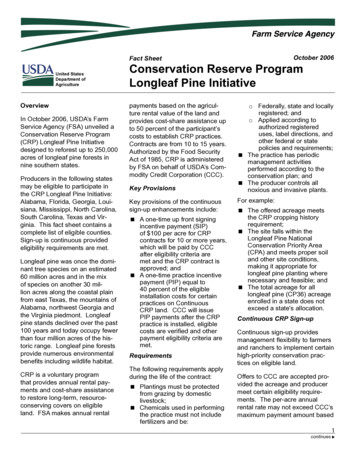
Transcription
October 2006Fact SheetUnited StatesDepartment ofAgricultureOverviewIn October 2006, USDA’s FarmService Agency (FSA) unveiled aConservation Reserve Program(CRP) Longleaf Pine Initiativedesigned to reforest up to 250,000acres of longleaf pine forests innine southern states.Producers in the following statesmay be eligible to participate inthe CRP Longleaf Pine Initiative:Alabama, Florida, Georgia, Louisiana, Mississippi, North Carolina,South Carolina, Texas and Virginia. This fact sheet contains acomplete list of eligible counties.Sign-up is continuous providedeligibility requirements are met.Longleaf pine was once the dominant tree species on an estimated60 million acres and in the mixof species on another 30 million acres along the coastal plainfrom east Texas, the mountains ofAlabama, northwest Georgia andthe Virginia piedmont. Longleafpine stands declined over the past100 years and today occupy fewerthan four million acres of the historic range. Longleaf pine forestsprovide numerous environmentalbenefits including wildlife habitat.CRP is a voluntary programthat provides annual rental payments and cost-share assistanceto restore long-term, resourceconserving covers on eligibleland. FSA makes annual rentalConservation Reserve ProgramLongleaf Pine Initiativepayments based on the agriculture rental value of the land andprovides cost-share assistance upto 50 percent of the participant’scosts to establish CRP practices.Contracts are from 10 to 15 years.Authorized by the Food SecurityAct of 1985, CRP is administeredby FSA on behalf of USDA’s Commodity Credit Corporation (CCC).Key ProvisionsKey provisions of the continuoussign-up enhancements include: A one-time up front signingincentive payment (SIP)of 100 per acre for CRPcontracts for 10 or more years,which will be paid by CCCafter eligibility criteria aremet and the CRP contract isapproved; and A one-time practice incentivepayment (PIP) equal to40 percent of the eligibleinstallation costs for certainpractices on ContinuousCRP land. CCC will issuePIP payments after the CRPpractice is installed, eligiblecosts are verified and otherpayment eligibility criteria aremet.RequirementsThe following requirements applyduring the life of the contract: Plantings must be protectedfrom grazing by domesticlivestock; Chemicals used in performingthe practice must not includefertilizers and be:o Federally, state and locallyregistered; ando Applied according toauthorized registereduses, label directions, andother federal or statepolicies and requirements; The practice has periodicmanagement activitiesperformed according to theconservation plan; and The producer controls allnoxious and invasive plants.For example: The offered acreage meetsthe CRP cropping historyrequirement; The site falls within theLongleaf Pine NationalConservation Priority Area(CPA) and meets proper soiland other site conditions,making it appropriate forlongleaf pine planting wherenecessary and feasible; and The total acreage for alllongleaf pine (CP36) acreageenrolled in a state does notexceed a state's allocation.Continuous CRP Sign-upContinuous sign-up providesmanagement flexibility to farmersand ranchers to implement certainhigh-priority conservation practices on eligible land.Offers to CCC are accepted provided the acreage and producermeet certain eligibility requirements. The per-acre annualrental rate may not exceed CCC’smaximum payment amount basedcontinues1
October 2006Fact SheetConservation Reserve ProgramLongleaf Pine Initiativeon the rental rate for the threepredominant soils for where theland is located. While acceptanceis not determined in a competitive offer process, producers mayelect to receive an amount lessthan the maximum payment rate.Sign-upSign-up begins Dec. 1, 2006,at local FSA offices for the CRPLongleaf Pine Initiative and runscontinuously until the 250,000acre goal is met, or Dec. 31,2007, whichever comes first.Eligible Land and PracticesTo be eligible for this practice,land must be in the nine states,within the historic range of thelongleaf pine and soils suitablefor longleaf pine. In addition, landmust first meet the basic CRP eligibility requirements. Acceptableland is cropland that was plantedor considered planted (includingfield margins) to an agriculturalcommodity in four out of six yearsbetween 1996 and 2001 andwhich is also physically and legally capable of being planted formanner normal for an agriculturalcommodity.Producer Eligibility RequirementIf a tenant, the producer mustparticipate with an eligible owneror operator.Rental RatesRental rates are based on threepredominant soils for land offeredfor enrollment. FSA bases rentalrates on the average value of dry-land cash rent for the past threeyears and adjusts rates to reflectthe relative productivity of soilswithin each county. The maximum CRP rental rate is calculatedin advance of enrollment.Cost-share PaymentsIn addition to the payments described above, CCC will pay up to50 percent of the eligible cost ofestablishing a permanent cover.Contract Effective DateThe effective date of the CRPcontract is the first day of themonth following the month of approval. In certain circumstances,producers may defer the effectivedate for up to six months.Length of ContractsContracts are for not less than 10,nor more than 15 years.Cooperating AgenciesCRP is administered by USDA’sFSA with assistance from USDANatural Resources ConservationService (NRCS); USDA ForestService; and local soil and waterconservation districts. Producers can research program detailsand offer acreage for enrollmentat their local USDA office, whichis listed in telephone books under“United States Government, U.S.Department of Agriculture.”For More InformationMore information about FSA andits programs can be found on theFSA Web site at: http://www.fsa.usda.gov.The U.S. Department of Agriculture (USDA)prohibits discrimination in all its programs andactivities on the basis of race, color, nationalorigin, age, disability, and where applicable,sex, marital status, familial status, parentalstatus, religion, sexual orientation, genetic information, political beliefs, reprisal, or becauseall or part of an individual’s income is derivedfrom any public assistance program. (Not allprohibited bases apply to all programs.) Persons with disabilities who require alternativemeans for communication of program information (Braille, large print, audiotape, etc.) shouldcontact USDA’s TARGET Center at (202)720-2600 (voice and TDD). To file a complaintof Discrimination, write to USDA, Director,Office of Civil Rights, 1400 IndependenceAvenue, SW., Washington, DC 20250-9410, orcall (800) 795-3272 (voice) or (202) 720-6382(TDD). USDA is an equal opportunity providerand employer.2continues
October 2006Conservation Reserve Program Longleaf Pine InitiativeEligible bamaAlabama3
RussellSt. evardCalhounCitrusClayColumbiaDe oroughHolmesIndian ridaFloridaFloridaFloridaFlorida4
PinellasPolkPutnamSt. JohnsSt. LucieSanta BaldwinBartowBen giaGeorgiaGeorgiaGeorgia5
dHoustonIrwinJeff rgia6
CaldwellCatahoulaEast Baton RougeEast FelicianaEvangelineGrantJacksonJefferson DavisLa SalleLivingstonNatchitochesRapidesSabineSt. HelenaSt. TammanyTangipahoaVernonWashingtonWest ppiMississippi7
efferson nMadisonMarionNewtonPearl ssippiMississippiMississippiNorth CarolinaNorth CarolinaNorth CarolinaNorth CarolinaNorth CarolinaNorth CarolinaNorth CarolinaNorth CarolinaNorth CarolinaNorth CarolinaNorth CarolinaNorth CarolinaNorth CarolinaNorth CarolinaNorth CarolinaNorth CarolinaNorth Carolina8
MooreNashNew eeLexingtonMcCormickMarionMarlboroNorth CarolinaNorth CarolinaNorth CarolinaNorth CarolinaNorth CarolinaNorth CarolinaNorth CarolinaNorth CarolinaNorth CarolinaNorth CarolinaNorth CarolinaNorth CarolinaNorth CarolinaNorth CarolinaNorth CarolinaNorth CarolinaNorth CarolinaNorth CarolinaNorth CarolinaNorth CarolinaNorth CarolinaNorth CarolinaNorth CarolinaNorth CarolinaNorth CarolinaSouth CarolinaSouth CarolinaSouth CarolinaSouth CarolinaSouth CarolinaSouth CarolinaSouth CarolinaSouth CarolinaSouth CarolinaSouth CarolinaSouth CarolinaSouth CarolinaSouth CarolinaSouth CarolinaSouth CarolinaSouth CarolinaSouth CarolinaSouth CarolinaSouth CarolinaSouth CarolinaSouth CarolinaSouth CarolinaSouth CarolinaSouth CarolinaSouth CarolinaSouth CarolinaSouth CarolinaSouth Carolina9
ePolkSabineSan nsvilleIsle of WightSouthamptonSuffolkSouth CarolinaSouth CarolinaSouth CarolinaSouth CarolinaSouth iaVirginiaVirginiaVirginia10
is listed in telephone books under “United States Government, U.S. Agriculture.” Department of For More Information and More information about FSA . Bulloch Georgia Burke Georgia Calhoun Georgia
